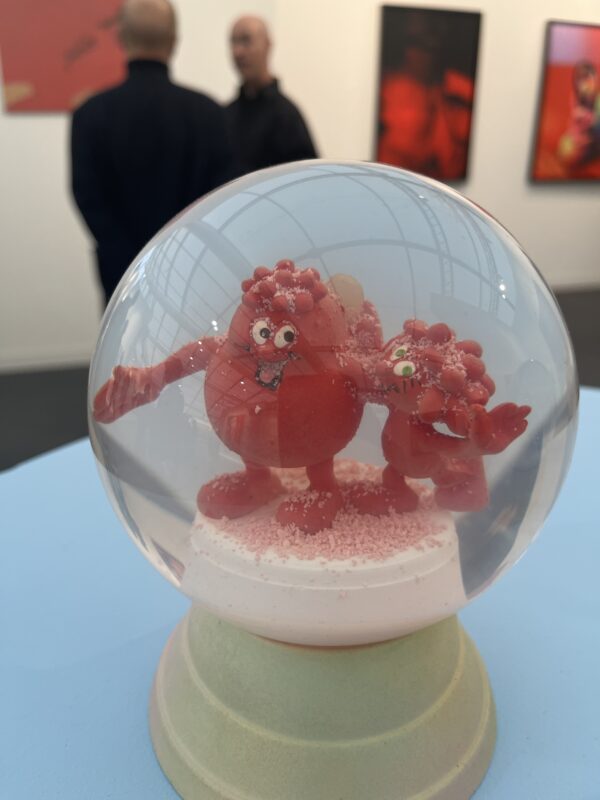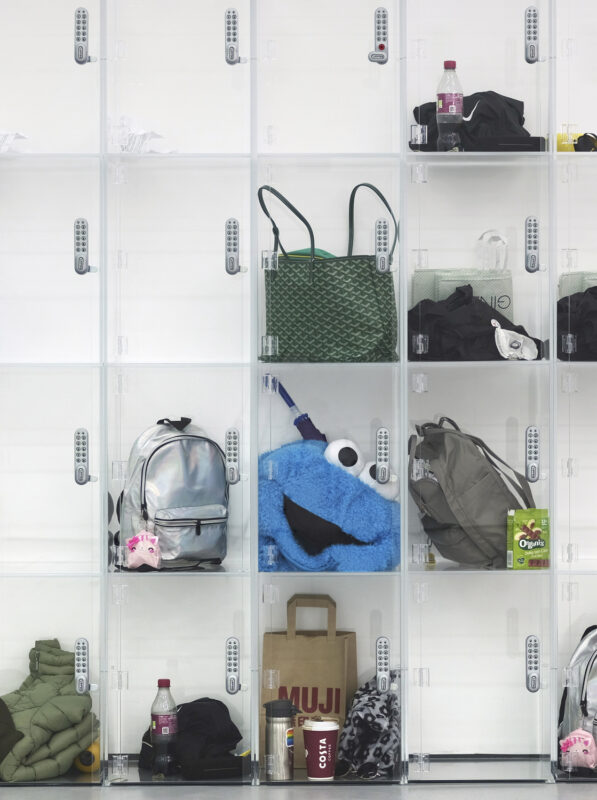Gander probes at what art is, the beauty to be found in new perspectives, and the commodity of attention in THIS IS FEELING ALL OF IT at Esther Schipper, Berlin.
“Have you ever read Sherlock Holmes?” Ryan Gander asks me, when we sit down to discuss his third solo exhibition with Esther Schipper, now on view in Berlin. He explains, “That’s what I do, I code and decode things—whether it’s a traffic light saying ‘go’ or footprints in the snow or a cigarette with lipstick on the floor. These objects are all catalysts, the evidence of stories.”
Gander rejects the idea of a practice, which in itself signals the aim of perfection. Instead, like Sherlock, the artist is always looking closer, differently, and questioning everything, whether it’s through re-examining portrait making or infusing a virtual world with a dose of reality. In fact, Gander is brainstorming so much, he has actually decided to give some of his ideas away. Step inside the gallery to be confronted by life’s big questions, see “paintings” on used restaurant napkins, and to take an idea for yourself. Below we discuss the epidemic of distraction in today’s society and how he sees artists’ role in it all.

As visitors enter the gallery they are confronted with a massive ball. For this work, you asked people to give you questions that couldn’t be answered? These “big questions” essentially block the entrance into the gallery forcing the viewers to confront them.
A lot of the questions are from people, a lot of the questions are from kids, because I know that they have abstract minds. It’s really abstract questions that play with language. Essentially, it’s because in education our kids are told to remember answers all day. It doesn’t make any sense, especially because we have machines to remember things for us and before that we had books. What we’re not taught is to ask questions. Most of the questions that we have the answers to are out of date. This is where discrimination comes from. Prejudice is a compound, isn’t it? We prejudge based on out of date proof of things. When we’re older and more removed from the culture of learning, we forget to ask ourselves these questions again, to see if the answers have changed. The answers change because the world is changing all the time.
Are you trying to encourage your audience to continue to ask questions?
I’m trying to encourage myself to do it! It’s a good reminder, personally, for me to keep questioning everything. It’s a good way to bring up the subject that our Victorian model of education is completely illogical and irrational. Education—the way it is in most Western cultures—is not fit for purpose. We could be using school as an opportunity to teach humans to do things that machines can’t do. But instead we just teach humans to remember stuff.
Does this interest come from your personal experience with the education system as a student and as a father?
It’s hard to make work about education because as soon as you say education, people think it’s about children. Making work about education is really unfashionable, it’s like social work. It sort of relates to the problem I was just speaking about. It’s because adults (“grown olds”) are further away from the culture of learning. So we imagine learning is for people who don’t have knowledge or no way to interpret information, but the people that are really happy in life are the ones that believe in lifelong learning. Learning is wonderful, it fills you with agency and hope and positivity. I’ve learned more now than I’ve learned in school. So it’s not education that I’m interested in, it’s development.

You have also installed a machine that distributes your ideas as a way for you to “exorcize the ghosts of your ideas” in the act of giving them away. Can you expand on this?
As an artist, the main task is not to make art, the main task is to have ideas. I have all these ideas collected, there’s an archive system in the studio, something like 200,000 ideas written down. I’ve got too many ideas and when you have that many ideas in front of you, it freaks you out. Time is limited and time is our greatest asset. There’s an intense emotive mortality. I’ve spent a lot of sleepless nights worrying that I’m working on the wrong idea. I think about running out of time. It’s like midlife crisis therapy, giving away all your ideas.
The large installation of toys was inspired by the way your son ordered his toys at home. Is that correct?
Baxter, he’s five and he has autism and one of his traits is that he likes patterns. He orders them in straight lines and he makes a pattern. His patterns are purely compositional. It’s not color or subject or size, it’s an emotional landscape. I like the collisions between the things and the changes in scale. If you gave a neuro-typical the toys, they would just separate them into categories (color, size, type, animals, etc). to make order and logic of things. Here, there is no prejudice of control, you just let go. Baxter thinks about things differently. His collisions are sporadic and quite wonderful, a bit like the world the way things collide accidentally, it’s like he’s showing us that.
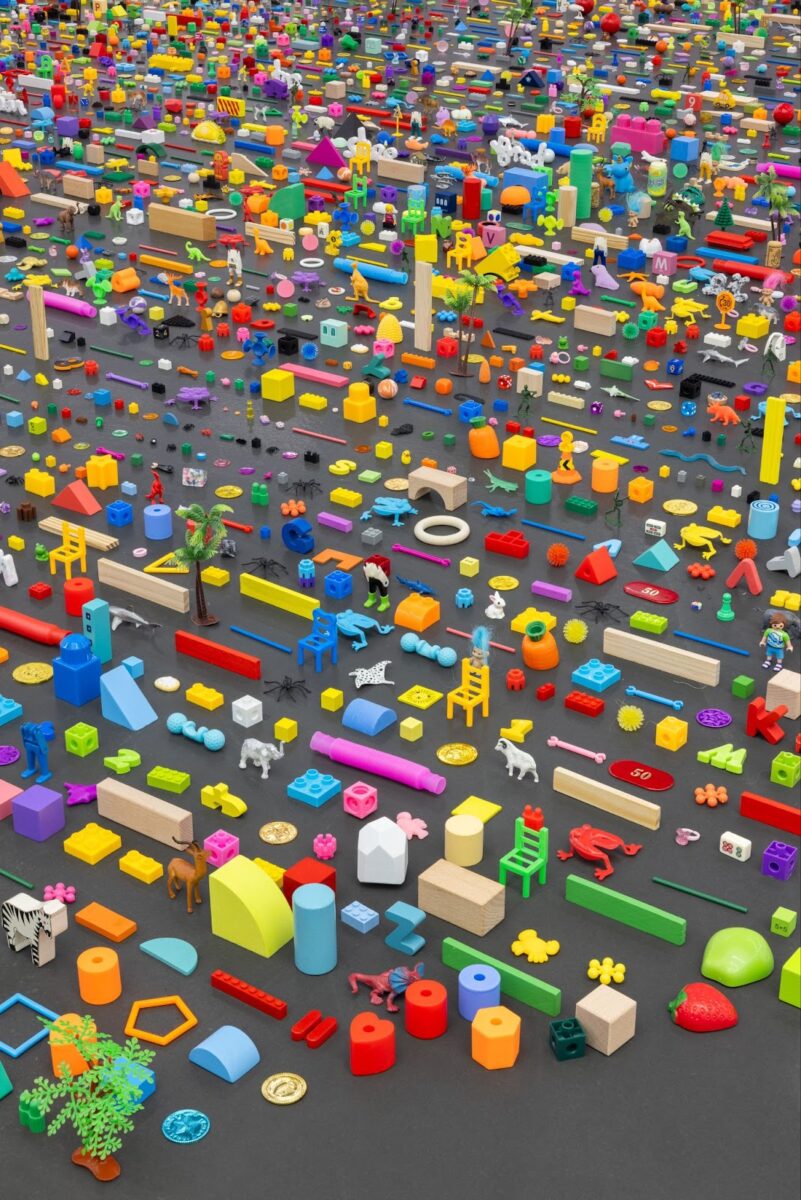
There is also a wonderful portrait of your son Baxter in the exhibition, printed on 1500 metal postcards addressed to your son. For this, you really stepped outside of the traditional portrait model.
I learned a lot from this work. When you read about autism, it’s not that people on the autism spectrum don’t fit in the world, it’s that the world doesn’t fit them. It’s a perspective change which I found to be beautiful. I have made portraits of my other children and I realized I was trying to squeeze him into my way of thinking. I was trying to make a portrait of Baxter based on how I made a portrait of the other kids. So, this is Baxter moving across the kitchen at home for 20 seconds. It’s a durational portrait.
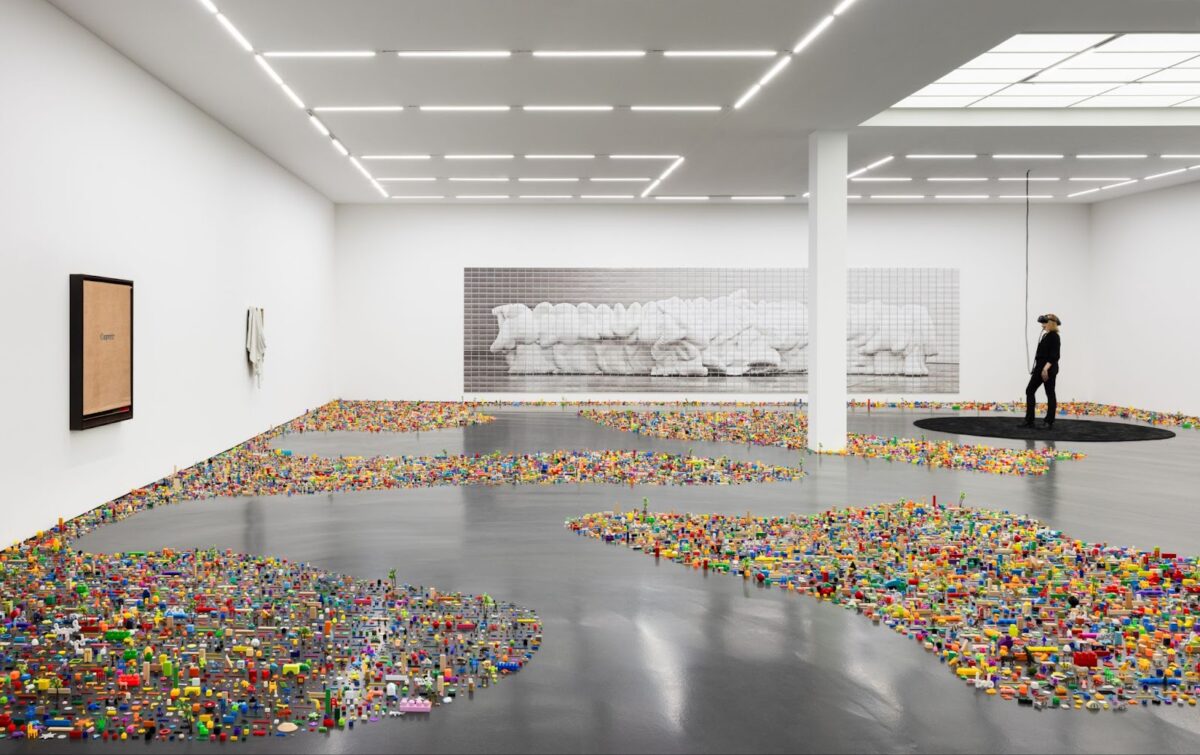
Despite the work drawing direct inspiration from your family, you wouldn’t say your work is personal?
I don’t really make work about me. Personally, I happen to use a wheelchair. So many people have a vulgar obsession with identity—everyone needs a label. The art world loves identity politics. I think it’s exclusive and limiting. I’m interested in universal subjects. I want to make work that everyone can relate to and I don’t want to make personal work. My son thinks differently and communicates differently which is cool. It’s emotional because it’s my son. I broke some of my own rules doing it. It was worth it.
I want my work to be about language and development, semiotics and visual language. My son has taught me more about it than anyone has.
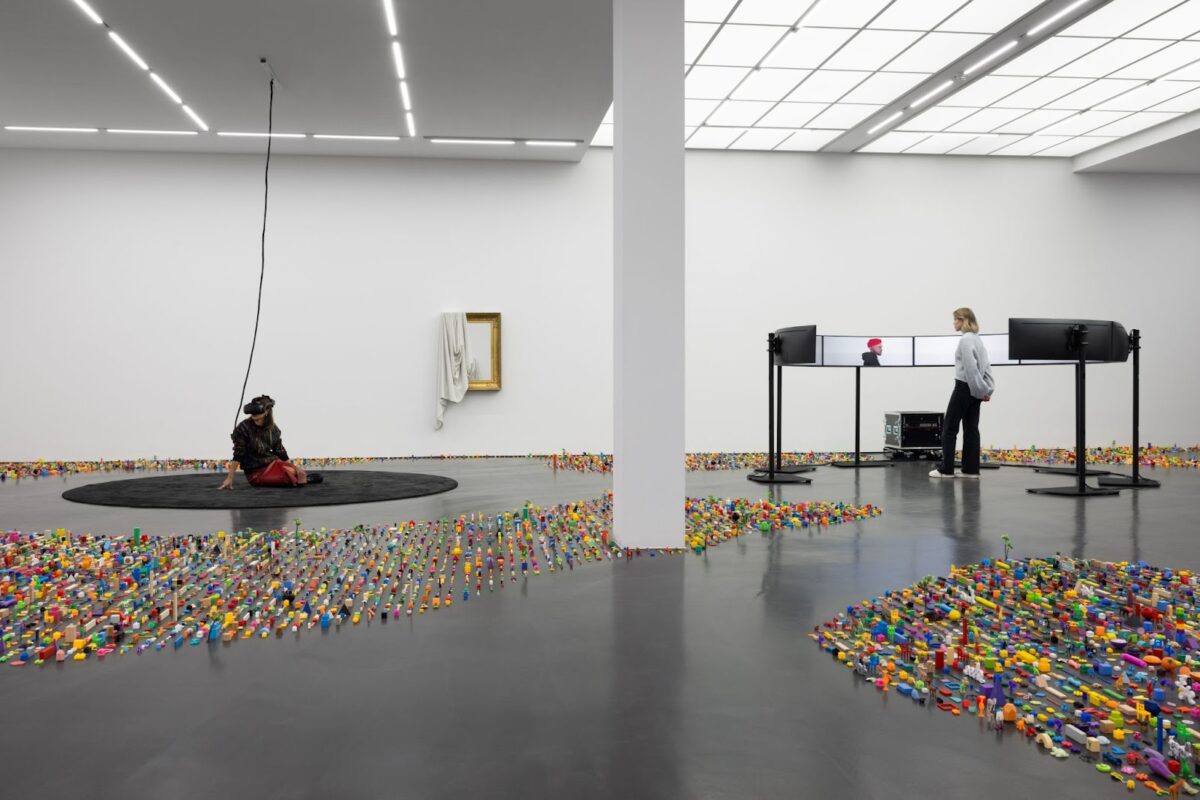
Let’s move to the VR work “Ryan Waiting” that you produced with VIVE Arts for the exhibition. This virtual version of you will have a lifespan of 100 years, outliving us all. For this artwork, you took virtual reality a different direction than most. Can you share more?
Exactly. It’s me being trapped in a void. The work is really about what nothing is, what boredom is. It’s good to re-sensitize ourselves, to re-level our sensitivity. The depth of the experience is important and we shouldn’t settle for shallow experiences. My kids saw it and thought it was hilarious because it was just like me, with my mannerisms and movements, but of course the audience doesn’t really know me like they do, so they won’t realize.
VR works are often unicorns and spacemen. I’m more interested in what’s happening in the real world rather than doing anything I want because it’s a virtual world. I wanted to do VR work that was primarily artwork, to show people it can be just like real life. Just because you have a world where anything is possible, where you can fly, doesn’t mean you should fly. It can be as boring as real life—it’s not entertainment. I’m challenging the attention economy.
Much of your work addresses the attention economy and the human tendency to distract ourselves.
Yes, essentially we’re all scared of dying. We don’t know what time is, we don’t know what happens after we die. We weren’t really meant to be this self aware and we can’t really handle it. We invent distractions. This is the attention economy. People understand that our attention has value. The world is over sensationalized and we have become desensitized. Everything is flashy: lights, colors, words, balloons, kittens, teddy bears… I’m thinking that where we are in time now is the devolution of humans. We have a huge attention and distraction problem, there is an epidemic of mental health problems. Sensationalism is overstimulation. We’ve lost the know-how: how to feel deep and think slow.
The positive thing in all this is that the world is completely amazing. I think it’s art’s role not to try and be better than the world. It’s alright for art to be second best after life and everything that’s outside the gallery is a million times better than anything that could be in the gallery.
Ryan Gander, THIS IS FEELING ALL OF IT – 7th December at Esther Schipper, Berlin
All images: Exhibition view: Ryan Gander, THIS IS FEELING ALL OF IT, Esther Schipper, Berlin 2024. Courtesy the artist and Esther Schipper, Berlin/Paris/Seoul. Photo © Andrea Rossetti © The artist / VG Bild-Kunst, Bonn 2024.
